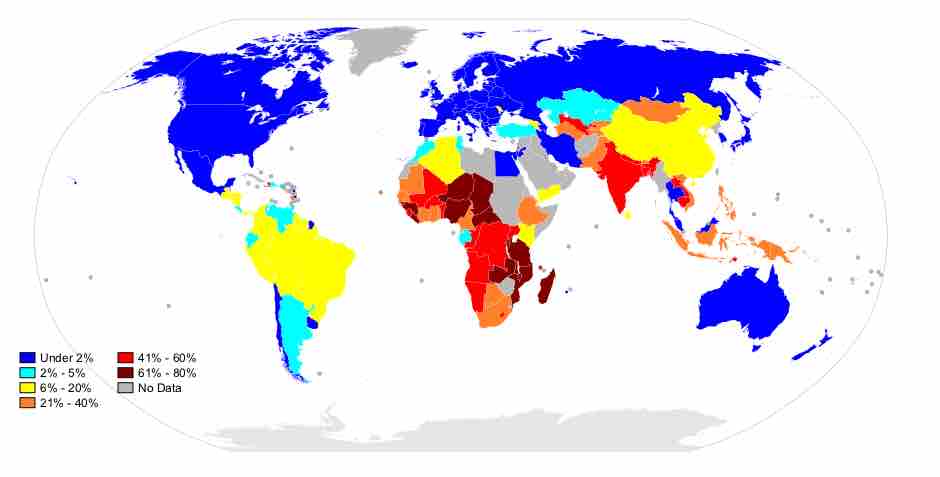There is a vast gap between the wealth of the world's richest countries and its poorest, resulting in different access to resources and opportunities for each country's population. To discuss this global inequality, sociologists may refer to the world's "twin peaks," or two groups of its richest and poorest countries. At the top of the hierarchy, a group of countries that includes the United States, Japan, Germany, the United Kingdom, France, and Australia has 13% of the world's population but receives 45% of its income (adjusted for international purchasing power). At the bottom of the hierarchy, a group of countries including India, Indonesia, and China has 42% of the world's population but receives only 9% of income (adjusted for international purchasing power). The existence of these twin peaks demonstrates that there is a wide gap between the world's wealthiest and poorest nations.
Throughout most of the 20th century, there was a trend towards divergence between the economies of richer and poorer countries. In other words, the gap between wealthy, developed nations and poorer, developing nations widened — global inequality increased. Current research indicates, however, that global inequality peaked around 1970. Around the year 1970, world income was distributed between extremely rich and extremely poor countries, with little overlap. Since the 1970s, trends show that an increasing percentage of the world's population lives in middle-income countries. Thus, there is a broader spectrum of incomes, with fewer people living at the extremes of wealth and poverty than in the past. Since 1970, global inequality has decreased.

Global inequality
As of 2009, there was still a stark divide between the wealth of the world's richest countries and its poorest, but an increased number of countries had middle-incomes as compared to the years prior to 1970. Global inequality remained persistent but had decreased somewhat.
Even though global inequality has decreased in recent decades, inequality is persistent and shows no signs of disappearing. Evidence used by researchers to demonstrate the presence of global inequality includes: the poorest 10% of Americans have a higher standard of living than 2/3 of the world's population; the richest 1% of the world's population holds as much wealth as the poorest 10% of the population; and the three richest individuals in the world possess greater wealth than the poorest 10% of the population. These statistics are small glimpses of the big picture of global economy, but begin to illustrate the great inequality that exists.
Sociologists who study global inequality have proposed social reproduction theory as one way to explain the persistence of inequality. According to social reproduction theory, rich and powerful individuals and institutions perpetuate inequality to protect their high status. The rich and powerful control the means of production (such as factories, land, and transportation) and often have strong influence in government. Moreover, they often control the media, schools, and courts, extending their influence in various social realms. Because individuals and institutions at the top of the economic hierarchy benefit from their status, they use their influence to protect their positions.
A related explanation for the persistence of inequality is the idea that culture teaches acceptance of the extant economic hierarchy. According to this view, individuals are taught to believe that the rich and powerful are more talented, hardworking, and intelligent than the poor. This explanation holds that the misconception that poor people are lazy or irresponsible is widespread, and that people are therefore likely to accept that poor people deserve to be poor. People who ascribe to the cultural belief that the rich are deserving of their wealth are unlikely to challenge economic inequality, so they thereby perpetuate it.